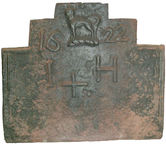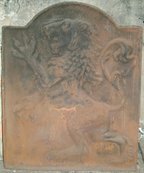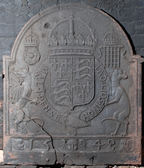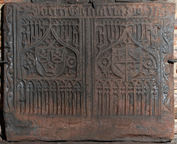-
206
Description: Rectangular with two-stepped top; double astragal edging on sides; top centre, stamp formed of a talbot statant guardant upon a wreath; date split either side of crest; initials below date, ‘+’ below letters.
Notes: The talbot crest is seen on other firebacks indicating a common source.
Copies of this fireback are known.
Inscription: 16 22 / I + H
- Decoration tags:
- stepped (shape)
- fillet (edging)
- simple stamps
- carved stamps
- individual numbers
- heraldic
- text
Manufactured: in 1622 in the Weald area of England.
Current location: St Mary's House, Bramber, West Sussex, England.
- Attached to series:
- Talbot crest series
- Stepped firebacks
-
22
Description: Arched rectangular shaped; fillet edging; a lion rampant
Notes: Whole pattern. A modern design of fireback
Copies of this fireback are known.
- Decoration tags:
- rectangular with round arch (shape)
- fillet (edging)
- whole carved pattern
- heraldic
- animals
Manufactured: in the late-19th to early-20th century in England.
Current location: St Mary's House, Bramber, West Sussex, England.
- Attached to series:
- Miscellaneous pattern firebacks
-
349
Description: Arched rectangular shape; ovolo-moulded edging; Tudor royal shield, garter, crown, motto and supporters (crowned lion and dragon); Tudor rose to right of lion’s head, portcullis to left of dragon’s head; temp. Elizabeth I.
Notes: Three versions of this fireback are known, with differing edging and one without the rose and portcullis.
Copies of this fireback are known.
Inscription: [Garter] HONI SOIT QVI MAL Y PENSE / [motto] DIEV ET MON DROIT.
Arms: Tudor royal
- Decoration tags:
- rectangular with round arch (shape)
- ovolo (edging)
- whole carved pattern
- heraldic
- armorial
- royal
- text
Manufactured: in the late-16th century possibly in the Weald area of England.
Current location: Bramshill House, Bramshill, Hampshire, England.
Citation: Baines, J. M., 1958, Wealden Firebacks (Hastings Museum).
- Attached to series:
- Tudor royal armorial firebacks
-
1268
Description: Quasi-arched shape with forward-facing 'wings', which splay outwards towards the base; the 'wings' curve to follow the shape of the main panel but curl outwards at the top; central panel with stylised image of a tree; top centre, three ostrich feathers gathered at their quills, on either side of which, on the curled upper parts of the 'wings', are a mirrored feature of uncertain type.
Notes: This small, but unusual, casting was probably cast in an open box mould. Only a very small number of such castings are known. Depth 210mm. The fireback has been repaired in the main panel and attached to a later grate.
- Decoration tags:
- free-standing (shape)
- none (edging)
- whole carved pattern
- plants
- objects
Manufactured: in the late-17th to early-18th century in England.
Current location: Bramshill House, Bramshill, Hampshire, England.
- Attached to series:
- Free-standing firebacks
-
207
Description: Arched rectangular shape; ovolo-moulded edge; Tudor royal shield, crown, garter and supporters (dragon and greyhound). Crowned rose on left, and crowned portcullis (grid of 16) on right side of crown; the supporters stand on a horizontal fillet; date panel with ovolo-moulding on top, central putto face splitting two parts of date with faces of putti in profile at each end.
Notes: Arms are of Edward VI. A very clear casting, almost certainly from the original pattern. There are several firebacks with the Tudor royal arms that were probably produced in the Spanish Netherlands, perhaps illustrating the association between England and Spain through the marriage of Henry VIII and Katherine of Aragon. The firebacks differ in several small details, such as the form and rotation of the Garter motto, the style of the crown, the positioning of the supporters in relation to the Garter, and the form and size of the crowned rose and portcullis.
Copies of this fireback are known.
Inscription: HONI SOIT QVI MAL I PENSE / 15 48
Arms: Tudor royal Edward VI
- Decoration tags:
- rectangular with round arch (shape)
- fillet (edging)
- whole carved pattern
- planklines
- heraldic
- armorial
- royal
- text
Manufactured: in 1548 possibly at Eisenschmitt Furnace in the Eifel area of Germany.
Current location: Ockwells Manor, Cox Green, Berkshire, England.
Citation: Kippenberger, A. 1973, Die Kunst der Ofenplatten (Düsseldorf, Verlag Stahleisen), p. 107.
-
810
Description: Rectangular; carved strip with undulating vine between fillets, repeated on each side; carved inscription panel along top edge; centre, two traceried panels, each with a central shield beneath a gothic arch.
Notes: One of several similar firebacks produced in the same period.
Copies of this fireback are known.
Inscription: JHESUS MARIA JHONES
- Decoration tags:
- rectangular (shape)
- fillet (edging)
- simple stamps
- carved stamps
- architectural
- armorial
- text
Manufactured: in the early-16th century possibly in the Eifel area of Germany.
Current location: in private hands, Cox Green, Berkshire, England.
- Attached to series:
- Foreign armorial firebacks
-
208
Description: Canted rectangle; twisted rope edging (top and sides); quasi-symmetrical arrangement of four fleurs-de-lys in star, top centre, two fleurs each side along top edge, single fleurs beneath outer top fleurs; short rope length in vertical and inverted 'V' shapes each side between top fleurs; ?dagger handle irregularly positioned centre left and right.
Notes: The style and shape of the fleurs-de-lys is unique to a particular series of firebacks, suggesting the same source; the 'V' shapes may have apotropaic significance. A sketch of this fireback c.1891 is in the collection of J. Starkie Gardner's sketch books at the Victoria and Albert Museum, Archive of Art and Design (AAD/2014/8); at the time of drawing it was stated to be in the ownership of one Simmons, a furniture dealer of Lewes.
- Decoration tags:
- rectangular with canted top corners (shape)
- rope (edging)
- simple stamps
- carved stamps
- heraldic
Manufactured: in the mid-16th century in the Weald area of England.
Current location: in private hands, Cox Green, Berkshire, England.
- Attached to series:
- Royal series
-
120
Description: Rectangular; rope edge (top and sides); rose and crown within a shield, stamped twice, both inverted, down centre; rectangular stamp with griffin, twice, in top corners.
Notes: Five other firebacks bearing these stamps are known: one is also in Hastings, and one, dated 1569, is at Hadlow Down, Sussex. The locations of the other three are not known. Formerly part of the Ade Collection (from Grove Hill, Hellingly, Sussex).
- Decoration tags:
- rectangular (shape)
- rope (edging)
- carved stamps
- heraldic
Manufactured: in the mid- to late-16th century in the Weald area of England.
Current location: Hastings Museum and Art Gallery, John's Place, Bohemia Road, Hastings, East Sussex, England.
Museum number: HASMG: 1952.51.11 (part of the Hastings Museum museum group)
Citation: Baines, J. M., 1958, Wealden Firebacks (Hastings Museum).
- Attached to series:
- Griffin series
-
651
Description: Rectangular; cavetto edging; a left-facing cockerel grasps a snake in its beak, another snake writhes on the ground behind it; date to left of the cockerel’s tail; four vertical planklines.
Notes: The design may have religious significance, the snake symbolising sin and the cockerel denoting St Peter’s denial of Christ. The ‘1’ of the date is hooked, suggesting a common source with firebacks designed by the pattern-maker, IM. A copy of this fireback is set into the brickwork of 16 Old Church Street, Chelsea, London.
Copies of this fireback are known.
Inscription: 1652
- Decoration tags:
- rectangular (shape)
- cavetto (edging)
- whole carved pattern
- planklines
- pictorial
- biblical
- text
- animals
Manufactured: in 1652 possibly at Brede Furnace in the Weald area of England.
Current location: not known.
- Attached to series:
- Small cavetto series
- Hooked '1' series
- New Testament firebacks
- Brede group
-
850
Description: Canted rectangle; elaborate cavetto moulded edging (top and sides); strapwork shield with a demi-flower at each side, between initials (S only visible); arms quarterly of six, 1st Or two chevronels Gules, on a canton of the last a mullet of the first (Pope); 2nd Argent three bars Gules, on a canton ermine a bend of lozenges of the second (Walshe); 3rd Sable three laurel leaves in bend Or between two bendlets Argent (Waller); 4th Azure a chevron between three crosses Moline Argent (Lansdale); 5th Ermine on a bend Gules three lions’ heads erased Or (Weston); 6th Azure a lion rampant Or supporting a cross patée fitchée of the second (Pichingham).
Notes: The excrescence over the third quartering is the result of the iron being poured directly onto the mould. The second initial is known from another casting. The date above the shield has been inserted before casting and differs slightly from another example of the same back.
Copies of this fireback are known.
Inscription: 1625 / S [P]
Arms: Pope (Sackevile Pope (b. 1589) of Hendall, in Buxted, Sussex)
- Decoration tags:
- rectangular with canted top corners (shape)
- complex individual (edging)
- whole carved pattern
- date stamp
- armorial
- text
Manufactured: in 1625 in the Weald area of England.
Current location: not known.
- Attached to series:
- Personal armorial firebacks
- Low relief armorial series







.jpg)

